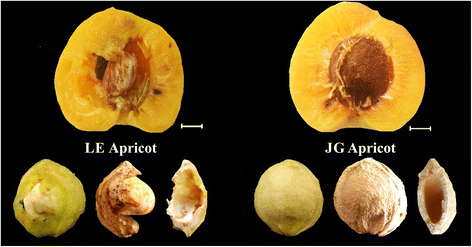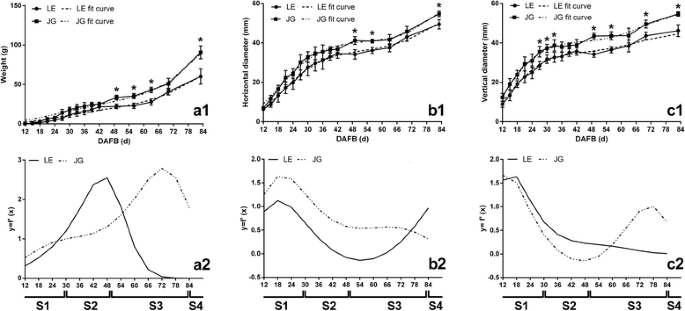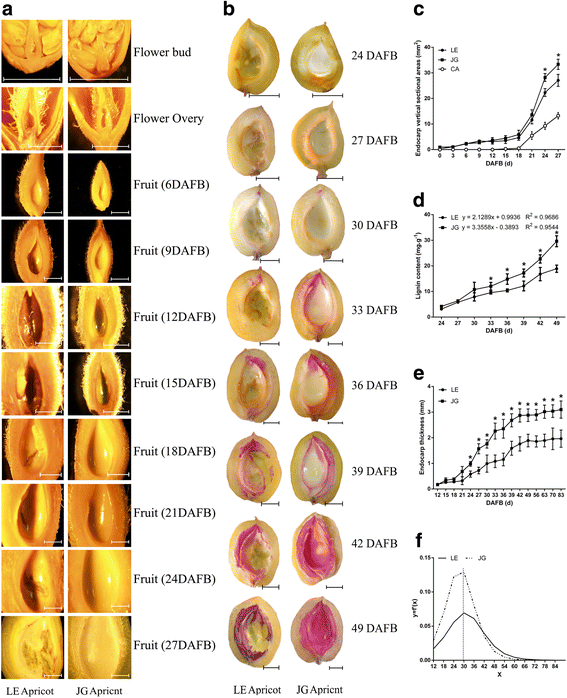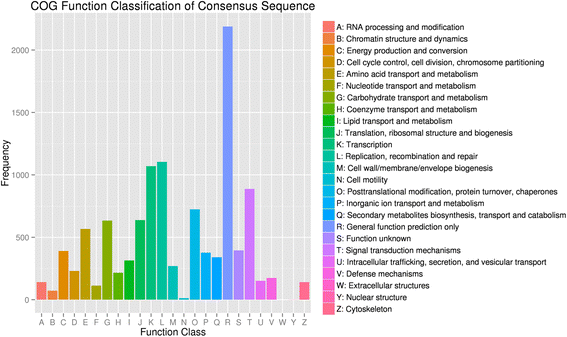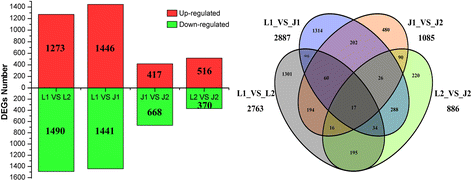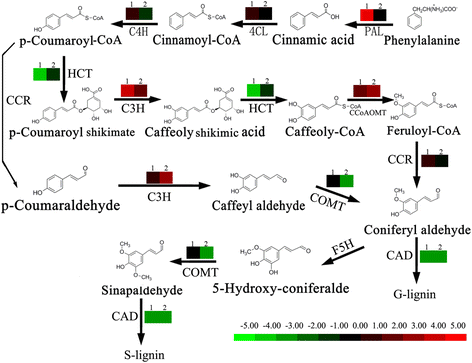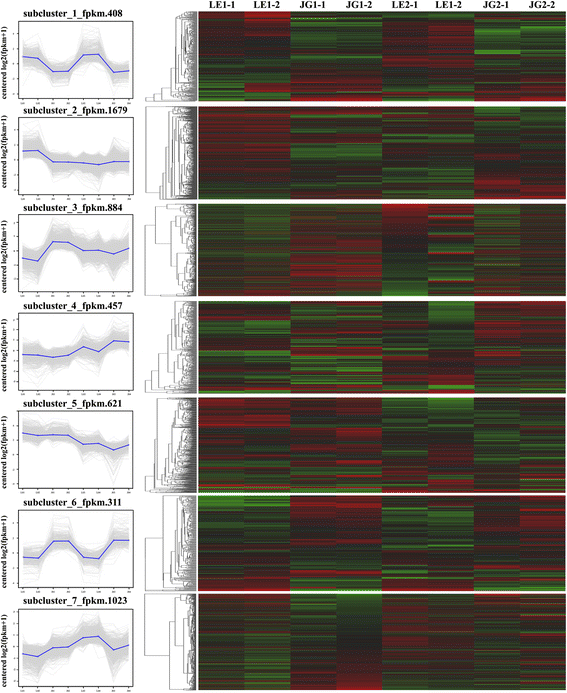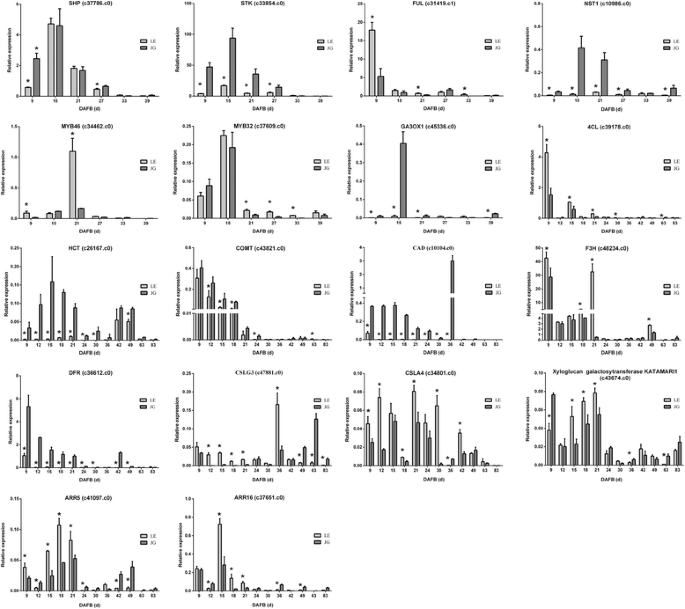- Research article
- Open Access
- Published:
比较转录组分析和形态provide insights into endocarp cleaving of apricot cultivar (Prunus armeniacaL.)
BMC Plant Biologyvolume17, Article number:72(2017)
Abstract
Background
A complete and hardened endocarp is a typical trait of drupe fruits. However, the ‘Liehe’ (LE) apricot cultivar has a thin, soft, cleavable endocarp that represents 60.39% and 63.76% of the thickness and lignin content, respectively, of the ‘Jinxihong’ (JG) apricot (with normal hardened-endocarp). To understand the molecular mechanisms behind the LE apricot phenotype, comparative transcriptomes ofPrunus armeniacaL. were sequenced using Illumina HiSeq™ 2500.
Results
In this study, we identified 63,170 unigenes including 15,469 genes >1000 bp and 25,356 genes with Gene Function annotation. Pathway enrichment and expression patterns were used to characterize differentially expression genes. The DEGs encoding key enzymes involved in phenylpropanoid biosynthesis were significantly down-regulated in LE apricot. For example, CAD gene expression levels, encoding cinnamyl alcohol dehydrogenase, were only 1.3%, 0.7%, 0.2% and 2.7% in LE apricot compared with JG cultivar at 15, 21, 30, 49 days after full bloom (DAFB). Furthermore, transcription factors regulating secondary wall and lignin biosynthesis were identified. Especially forSECONDARY WALL THICKENING PROMOTING FACTOR 1(NST 1), its expression levels in LE apricot were merely 2.8% and 9.3% compared with JG cultivar at 15 and 21 DAFB, respectively.
Conclusions
Our comparative transcriptome analysis was used to understand the molecular mechanisms underlie the endocarp-cleaving phenotype in LE apricot. This new apricot genomic resource and the candidate genes provide a useful reference for further investigating the lignification during development of apricot endocarp. Transcription factors such as NST1 may regulate genes involved in phenylpropanoid pathway and affect development and lignification of the endocarp.
Background
Apricot (P. armeniacaL.) is a typical drupe of the family Rosaceae with eight pairs of chromosomes (2n= 16) [1]。Cultivated apricots are widely cultivated around the world (Asia 59.9%, Europe 21.6%, Oceania 0.4%, Africa 15.8%, and Americas 2.3%. FAO, 2013–2014) and apricot production has a relatively high economic value. Apricot fruit has rich nutritional value, including dietary fiber, organic acids, vitamin C, carotene, and trace elements [2]。Furthermore, the kernel is a natural plant protein resource, which used as medicine and food [3]。
的pericarp develops from the ovary, and the innermost layer is the endocarp. The hardened endocarp has a vital role in seed protection and dispersal in some important economic fruits, such as peach, apricot, plum, almond, cherry, mango, olive, and coffee [4]。In plant evolution, the function of the heavily lignified endocarp is to ensure secure environment for seed development [5,6]。Endocarp hardening is a significant trait of mature drupe fruits. It is caused by the secondary wall formation and lignin deposition [6]。Biochemical analysis has found that the endocarps of olive and peach contained much more lignin than poplar stem [7], suggesting that a relatively extreme degree of secondary wall formation occurs in fruit endocarp tissues. Lignin is an aromatic polymer that is widely found in the secondary walls of plants, as well as most enzymes and regulatory steps in the lignin biosynthetic pathway (phenylpropanoid pathway) have been identified [8]。Endocarp lignification inArabidopsishas been adequately studied in relation to dehiscence, and even the transcriptional regulatory network has also been examined [9]。For drupe fruits, Ryugo [10] observed the regulation of lignin biosynthesis and accumulation in peach stones in the early 1960s. Lignification in peach endocarp is a highly coordinated process, which has been shown by subsequent developmental studies [11]。Recently, a transcriptional network dominated byNACandMYBgenes was observed in a well-conserved regulatory pathway, which causesArabidopsisdehiscence or peach endocarp formation [4], and plays an essential role in the secondary wall formation and lignification via stimulating the pathway. Furthermore, several MADs-box genes involved in the formation of fruit endocarp, includingSHP1, SHP2,STK,andFULwere identified [12]。的se TFs co-function withIND,ALC[13], andRPL[14] to stimulates endocarp differentiation.
However, there is wide variation in the phenotypes ofPrunusendocarps, such as thickness, hardness, and brittleness of almond endocarps. The endocarp of “split pit” peach does not seal along the suture, leaving the seed severely exposed to pests and disease [15]。Callahan [16] found a natural “stoneless” plum in a wild-typeP. domestica, which had imperfectly developed endocarp resulting in a partially naked seed. China has a great wealth of germplasm genetic resources of apricot that have important breeding values [17]。‘Liehe’ (LE) apricot is an extremely rare cultivar that originated in Linyuan City of Liaoning Province and was introduced into National Germplasm Repository for Plums and Apricots (Xiongyue, Liaoning, China) in the 1983 [18]。的endocarp of LE apricot is thin, soft, and cleavable, and some seed partially exposed (Fig.1)。Both flesh and kernel have a tasty flavor and aroma.
This study investigated the mechanisms of endocarp development and phenotype formation, using Illumina sequencing and expression pattern analysis of candidate genes in apricot fruits during the stages of endocarp development and lignification.
Results
Differences in endocarp development in LE and JG apricot
的growth of LE apricot fruit was compared with JG apricot. The horizontal and vertical diameter of the two cultivars increased continuously during fruit development. Growth patterns were similar, with formal double-sigmoid growth curves (Fig.2)。的equation of two apricot cultivars and their first derivatives were also similar (Additional file1: Table S1). In addition, the transcript level ofACO1andPEPCK两个杏的发展分为相同four stages (Additional file2: Figure S1). Based on these patterns and fit equations, apricot fruit growth was assessed at four growth stages: S1, first exponential growth stage (before 30 DAFB); S2, slow-growth stage (30–49 DAFB); S3, second exponential growth culminating in fruit ripening stage (49–83 DAFB); S4, fruit ripening stage (after 83 DAFB). The changes in the growth pattern during fruit development in LE and JG apricot were almost the same.
的changes of weight and growth curves of LE and JG apricot during fruit development stages. Ina1,b1,c1,points and solid linesrepresent actual measured values, and thedotted linerepresent fit curves of equation. Ina2,b2,c2, two different lines are fit curves of the first derivative of equations. Numbers under the x–axis indicate the days after full bloom. S1, first exponential growth stage; S2, slow–growth stage; S3, second exponential growth culminating in fruit ripening stage; S4, fruit ripening stage.Error barsindicate the standard deviation of ten biological replications. Label: ‘*’ means the significant differences atP< 0.05 by DMRT
Flower buds, flowers and young fruits of LE and JG apricot were examined to investigate the features of the innermost layer of the apricot ovary (Fig.3a)。的innermost wall of the flower bud and flower ovary were smooth and normal, even in the early endocarp of young fruit with no obvious differences. However, at 15 DAFB, endocarp of LE apricot started to cleave, and these areas increased along with the progression in fruit development, which occurred in virtually each replicate sample of LE apricot. Endocarp thickness was significantly different after 30 DAFB subsequently (Fig.3e,f), when cleaving areas of endocarp became more obvious in LE apricot (Fig.3b,c)。
Observation of development and lignification of the endocarp in LE and JG apricot.aMicroscopic observation of flowers and young fruits of two cultivars, the scale was 2 mm.bObservation of lignin deposition in two cultivars’ fruit, the scale was 5 mm.cChanges of endocarp vertical sectional areas in LE and JG apricot. ‘CA’ represent the cleaving areas of LE endocarp.dChanges of endocarp lignin content in LE and JG apricot.eChanges of endocarp thickness in LE and JG apricot.f的carve of first derivative of the endocarp thickness equation. Numbers under x–axis indicate the days after full bloom.Error barsindicate standard deviation of ten biological replications. Label: ‘*’ means the significant differences atP< 0.05 by DMRT
的lignin deposition process was discernible from fruit transverse sections (at 24 DAFB) showing color reaction between the phloroglucinol and lignin (Fig.3b)。的lignin deposition process began at the tip of the endocarp and gradually completed over 25 days (24–49 DAFB). Interestingly, LE cultivar exhibited incomplete areas of endocarp that had little or no lignification (Fig.3a,b)。的thickness and lignin content were significantly lower in LE endocarp, which estimated by 60.4% and 63.3%, respectively; out of that in JG endocarp (Fig.3d,e)。Thus the differences in endocarp development and lignification were significant.
Illumina sequencing and assembly
的LE endocarp cleaving occurred at 15 DAFB and rapidly increased at 21 DAFB (Fig.3a)。Thus, RNA from these two fruits stages of LE and JG apricot was used for RNA-seq, with two replicates per fruit, which generated 40,145,230,606 raw reads. After removing low-quality reads and trimming adapter sequences, 159,378,508 remained (Table1)。的assembly data were confirmed by an N50 value (1689 bp) and average length (868.72 bp). The number of transcripts (length ≥ 200 bp) was 152,146, constituting 99.99% of the total, with average lengths of 1579.75 bp (Table1)。Transcripts assembled 63,170 genes from LE and JG apricot. Among these genes, 15,469 had lengths of ≥1000 bp, constituting 24.49% (15,469/63,170) of the total (Table2)。Length distribution of all genes is shown in Table2.
Functional annotation and identification of unigenes
Based on the sequence similarity, 25,356 genes were matched to the Japanese apricot and peach genome databases (Additional file3: Table S2). All of these genes were aligned using BLASTx (E values ≤105) searches against the NR, Swiss-Port, GO, COG, and KOG protein databases, and KEGG pathway databases. A total of 25,356 (40.14%) genes had more than one match, and 39.78% were annotated to the NR database (Table3)。Among the annotated genes in the NR database, 74.08% had an E-value ≤1.0 E−5and showed very strong homology to the gene sequence in the database. The remaining 50.38% of genes had an E-value ranging from 1.0 E−6to 1.0 E−60(Additional file4: Figure S2). We further analyzed the BLAST results in the NR database and investigated the best-hit species distribution, and the top two matched plant species wereP. mume(63.67%) andP. persica(26.23%) (Additional file4: Figure S2).
预测基因的功能分类y GO analysis. A total of 16,506 genes annotated in the GO database were categorized into 57 functional groups, belonging to three main GO ontologies: biological processes, cellular components, and molecular functions (Additional file5: Table S3; Additional file6: Figure S3). ‘metabolic process’ (8408 genes, 50.93%), were dominant among the functional groups.
In addition, assembled genes were searched against the COG database to estimate the gene function (Fig.4)。总的来说,772年4 putative proteins were clustered into 25 functional categories. Among these categories, ‘general function prediction only’ (2188, 28.33%) accounted for the largest amount, followed by ‘replication, recombination and repair’ (14.29%) and ‘transcription’ (13.85%). In addition, 4.41% of assembled genes were assigned to secondary metabolites biosynthesis, transport, and catabolism, reflecting the large amount of secondary metabolites that were present in the apricot. The ‘nuclear structure’ (0.01%), ‘cell motility’ (0.17%), and ‘chromatin structure and dynamics’ (0.93%) accounted for the least amounts.
We used the KEGG pathway database to search the functional networks of biological interactions. In total, 4830 genes were identified in the KEGG database and were assigned to 118 KEGG pathways (Additional file7: Table S4). The majority of genes was classified into pathways for ‘carbohydrate metabolism’ (905 genes), ‘translation’ (596 genes), ‘amino acid metabolism’ (581 genes), or ‘folding, sorting and degradation’ (471 genes). Biosynthesis of other secondary metabolites matched 192 genes.
的expression patterns of the genes among LE1, LE2, JG1, and JG2 were calculated using the FPKM method. A total of 5385 DEGs were identified by comparing the four libraries in paired comparisons, as illustrated in Fig.5. The most prominent library was LE1_vs_JG1. In each library, LE1_vs_LE2, LE1_vs_JG1, JG1_vs_JG2, and LE2_vs_JG2 had 2763, 2887, 1085, and 886 DEGs respectively. Four libraries had 17 common DEGs and 1301 DEGs in LE1_vs_LE2, as well as 1314 DEGs in LE1_vs_JG1, 480 DEGs in JG1_vs_JG2, and 220 DEGs in LE2_vs_JG2. These results indicated that early fruit development of apricot is a highly active process, and key genes that are related to endocarp development were significantly expressed.
DEGs statistics and Venn diagrams between different cDNA libraries.Red colorindicates up–regulated expression of DEGs;Green colorindicates down–regulated expression of DEGs. L1 and J1: the DEGs were generated from LE relative to JG cultivar at 15 DAFB; L2 and J2: the DEGs of LE relative to JG cultivar at 21 DAFB. JG was always control sample
Transcript differences between LE and JG apricot
Endocarp cleaving and incomplete lignin deposition in the fruit of LE apricot were highly complex phenomena that caused by a series of biological processes, including many genes acting synergistically, collaborating in regulating various pathways. However, the phenylpropanoid pathway is undoubtedly one of the most important. Endocarp hardening occurs via secondary cell wall formation and lignification. In the phenylpropanoid pathway,p-coumaryl alcohol, sinapyl alcohol, and coniferyl alcohol are the end products that form the different types of lignin monomers [8]。From the KEGG enrichment analysis, phenylalanine metabolism, phenylpropanoid biosynthesis, and hormone signal transduction were the foremost pathways and contained the most number of DEGs in LE1_VS_JG1 (Additional file7: Table S4; Additional file8: Figure S4). Thirty-four DEGs associated with the phenylalanine pathway were differentially expressed.
的expression level of genes which involved in phenylpropanoid pathway was down-regulated in LE compared with JG cultivar, in both the replicates and development stages (Table4, Figs.6,8)。的se included genes encoding shikimateO-hydroxycinnamoyltransferase (HCT, unigene c42130.c0 and c26167.c0) [2.3.1.133], caffeic acid O-methyltransferase (COMT, unigene c43821.c0) [EC 2.1.1.6]. Among the seven annotated Peroxidase [EC 1.11.1.7] genes, two were down-regulated (unigene c10367.c0 and c36804.c0) in LE relative JG cultivar. Cinnamyl alcohol dehydrogenase (CAD, unigene c10104.c0) [EC 1.1.1.195] in particular, were involved in lignin biosynthesis and catalyzed the final step specific to the production of lignin monomers [19]。的expression level ofCADwas always down-regulated in LE relative to JG cultivar during S1 stage. The fold change data of each selected candidate gene in the phenylpropanoid pathway are shown in Fig.6, and detailed information is presented in Table4.
Expression of DEGs involved in phenylpropanoid pathway between LE and JG apricot. Expression pattern in this figure is from log2(FC).Red colorindicates higher levels of gene expression in LE relative to JG cultivar;Green colorindicates lower level of gene expression in LE relative to JG cultivar;Black colorindicates gene expression had little difference between LE and JG cultivar. Label ‘1’ on the pattern indicates relative expression at 15 DAFB; ‘2’ indicates the relative expression at 21 DAFB
Several TFs were identified that mediated the endocarp development, including SHP and STK. ALC and IND promoted endocarp differentiation and negative regulation was achieved by FUL and RPL. Meanwhile, NST1, NST3, and several MYB-box genes are associated with secondary wall formation and lignin biosynthesis. By the RNA-seq, the majority of these TFs and genes were identified and showed in Fig.8. The expression ofSHP,FUL, andMYB32were up-regulated in LE relative to JG cultivar. However,STK,MYB46–1,MYB46–2, andNST1were down-regulated significantly in LE compared with JG cultivar (Table5, Fig.8)。
We used common expression patterns to further analyze the DEGs between LE and JG apricot at 15 and 21 DAFB. Based on this method, 5383 DEGs were placed into seven clusters (Fig.7; Additional file9: Table S5). Most of the candidate DEGs was categorized in either Cluster 1 (408 genes) or Cluster 6 (311 genes). Compared with JG apricot, the expression of DEGs of LE apricot was up-regulated in Cluster 1, and some DEGs were present asCHS1,F3H,CSLG3,CSLA9,KATAM,ARR5, andARR16(Additional file9: Table S5). Conversely, the expression of DEGs such asDFRandXTH2in LE apricot was down-regulated in Cluster 6.
Common expression analysis based on DEGs expression patterns.Left: Numbers under the x-axis indicated different sample, numbers under the y-axis indicated the log2(fpkm + 1).Right:Red colorrepresents higher log2(fpkm + 1) data of genes;Green colorrepresents lower log2(fpkm + 1) data of genes.Black colorrepresents log2(fpkm + 1) = 0. LE1–1 and LE1–2 indicate two biological replications of LE at 15 DAFB; LE2–1 and LE2–2 indicate two biological replications of LE at 21 DAFB; JG1–1 and JG1–2 indicate two biological replications of JG at 15 DAFB; JG2–1 and JG2–2 indicate biological replications of JG at 21 DAFB
的re was a linear correlation (R= 0.9188,P≤ 0.0001) between RNA-seq data and qPCR in our study (Additional file10:图S5)。TFs (STK,SHP,FUL,NST1,MYB46, andMYB32) and key candidate genes could regulate fruit endocarp growth, development, and lignification (Fig.8)。的se genes involved in the biosynthesis of plant hormones (GA3ox1,ARR5, andARR16), phenylpropanoid pathway (4CL,HTC,COMT,andCAD), flavonoid biosynthesis (F3HandDFR), and cellulose-related pathway (CSLG3,CSLA9, andKATAM)。STK,NST1,GA3ox1,HCT, COMTandCADwere down-regulated andMYB32was up-regulated in LE apricot, compared with JG, in RNA-seq data and gene expression, respectively. Furthermore, Pearson’s correlation analysis indicated that there was a significant association betweenCADexpression and endocarp thickness in LE apricot at the 0.05 level.HCTexpression and lignin content also showed the same result (Additional file11: Table S6). The special endocarp development and lignification in LE were caused by the effects of several TFs and genes involved in phenylpropanoid pathway.
Discussion
的hardened endocarp has a vital role in seed protection and dispersal in some important economic fruits, such as peach, apricot, plum, almond, cherry, mango, olive, and coffee [4]。Endocarp hardening is a significant trait of fruit matures of any types of drupes, which caused by the secondary wall formation and lignin deposition [6]。Phenylpropanoid biosynthesis played a crucial role in endocarp lignification in both LE and JG apricot. Sequence analysis of transcriptome revealed a series of differentially expressed genes involved in the phenylpropanoid pathway, such as4CL,HCT,COMTandCAD. Knockout of4CLinArabidopsishad no significant effect on either lignin content or monomeric composition [20]。However, RNAi silencing ofHCLinArabidopsisandRadiata pinereduced lignin content and changed the monomeric composition [21,22]。InCOMTantisenseLeucaena leucocephala,the lignin content was reduced to 72% by decreasing 60% of OMT activity [23]。CAD1made a significant contribution to the synthesis of coniferyl alcohol, and down-regulatedCAD1in wild-type tobacco has a moderate impact on G unit content of the non-condensed lignin fraction [24]。CAD activities were drastically reduced in null mutants ofArabidopsis(AtCAD-DandAtCAD-C), and affected sinapyl alcohol dehydrogenase activity in these mutants.AtCAD-Dhad an significant influence on lignin content and proportion of conventional S lignin [25]。In LE cultivar, expression of4CLwere up-regulated, yet expressions ofHCLandCOMTwere down-regulated, which relative to JG cultivar (Figs.6,8)。In particular,CADexpressed down-regulated in LE apricot compared with JG, in both RNA-seq data and relative gene expression (Figs.6,8)。的se results indicated that thickness and incomplete endocarp are unlikely to result from mutation of one specific phenylpropanoid pathway gene. In fact, expression levels ofCADandHCThad significant correlation with endocarp thickness and lignin content in LE apricot (Additional file11: Table S6). These genes or TFs may be responsible for the defects in endocarp development and lignification in LE apricot.
SHP,STKandNST1were specifically expressed in endocarp of peach. In exocarp and mesocarp, the negative regulatorFULexhibited a high expression level. However, the expression ofINDandALCwas insignificant [4]。InArabidopsis stk shp1 shp2triple mutants, the integuments were changed into carpel-like structures leading to complete sterility [26]。Over-expression ofFULcaused no lignin deposition in valve tissues inArabidopsis[27]。Furthermore, in tomato, over-expression ofFUL2导致果皮薄,减少了干细胞layer [28]。In a split pit resistant variety of peach,SHPexpression was low, however in the sensitive variety,FULexpression was significantly elevated [15]。Our analysis found thatSTK,SHP, andFULwere discovered in DEGs, butINDandALCwere not. Expression ofSHPandFULhad significant different between LE and JG at 9 DAFB, whileSTKremained down-regulated during the S1 stage significantly. RNA-seq data and qPCR analysis reflected thatSHP,STK, andFULwere highly expressed and essential for endocarp development (Table5; Fig.8)。IND directly activates GA3ox1, which is an indispensable enzyme catalyzing the last step of GAs biosynthesis in the separation layer ofArabidopsis. IND induces GAs accumulation to degrade DELLA protein, resulting in release ALC [29]。Inatga3ox1 atga3ox2double mutants ofArabidopsis, synthesis of cellulose, hemicelluloses, and lignin were suppressed obviously [30]。NST1 and NST3 (SND1) have been proven as master switches that regulate the secondary wall biosynthesis and lignification inArabidopsis[31],Medicago[32], and Poplar [33]。In the transcriptional network, the downstream transcription factor MYBs is activated by NST1 and SND1, and multiple genes are involved in secondary wall biosynthesis [34]。Innst1mutants, valve margins were obvious in the absence of the secondary wall, meanwhile innst1 nst3double mutants, only vascular vessels conserved secondary wall formation [35]。的SND1, andVND1–5,VND6–7were not detected as DEGs in this study. The expression levels ofVND4were always lower in LE relative to JG cultivar at 15 and 21 days after full bloom (Additional file3: Table S2).NST1, the domain of that regulates biosynthesis of secondary wall, lignin and xylanase always had low expression levels in LE fruit (Table5; Fig.8)。This might be one of the main cause of cleaving and thinning of endocarp in LE apricot. Hence,NST1was regarded as an essential candidate gene in the development and phenylpropanoid biosynthesis in endocarp of LE apricot. MYB46 is also a decisive master switch andAtMYB46据报道,ANAC01的直接目标2/SND1/NST3 [36], which adjusted secondary cell wall biosynthesis [37]。Dominant repression or over-expression of MYB46 has a considerable effect on secondary wall thickening of fibers and vessels and biosynthesis of lignin and cellulose [36]。We identified two differentially expressedMYB46(Table5)。In addition, MYB46 could activate the expression of MYB4, MYB7, and MYB32 [38], and the MYB32 protein sequence was highly similar to that of MYB4 [39]。AtMYB4regulates the expression ofC4H, so thatAtMYB32could negatively regulate several genes implicated in phenylpropanoid biosynthesis [40]。Trans-activation assays and transgenic studies also show that MYB32 appears to be a negative regulator of SND1 expression [32]。Interestingly,MYB32was extraordinary up-regulated in LE, and expression ofC4Hdown-regulated (Fig.8) only in LE fruit. MYB32 of apricot might also play an important part in negative regulating the lignin biosynthesis in the secondary wall.
Common expression pattern analysis provided a new understanding of the expression and function of DEGs, and combines pathways with multiple candidate genes, which were related to the flavonoid pathway and cell function (Fig.7; Additional file9: Table S5).CHS1andF3Hexpressed higher level in LE than JG, which may cause by considerable down-expression ofCAD. However,DFRhad a down-regulated expression. Among 408 genes in Cluster 1,CSLG3, and related genes,CSLA9[41] andKATAMhad significant higher level expression in LE during stage S1 and S2 relative to JG cultivar. Furthermore,ARR5andARR16regulators appeared to act as negative regulators of Cytokinin signaling [42], and showed significantly up-regulated expression in LE apricot.
Conclusions
Our results implied that cleaving of endocarp in LE apricot started at 15 DAFB, and this area increased during fruit development. The thickness and lignin content of the mature LE endocarp was only 60.39% and 63.25%, respectively, compared with JG endocarp (Fig.3)。RNA-Seq to sequencing and de novo assembly of the fruit transcriptomes of two cultivars ofP. armeniaca(L.) showed discrepancies in development and lignification of the endocarp and explained the cleaving of endocarp in LE apricot. The DEGs and qPCR analysis data (Fig.8) identified differentially expression genes involved in TFs (STK, SHP, FUL, NST1, MYB46, MYB32) and phenylpropanoid, flavonoid and hormone pathways (4CL,HCT,COMT,CAD,CHS1,F3H,DFR,GA3ox1,ARR5, andARR16), consistent with endocarp phenotype and lignin content. Our results indicated that TFs especiallyNST1, may regulate genes of the phenylpropanoid pathway. Besides, low expression level ofNST1may inhibit the endocarp development and lignification of LE apricot.
Methods
Plant materials
‘Liehe’ (LE) apricot, synonym as ‘Luoren’ apricot, and ‘Jinxihong’ (JG) apricot are local cultivars originated respectively in Linyuan City and Jinxi County of Liaoning Province and were collected into National Germplasm Repository (N40°10′1.18″, E122°09′39.41″) for Plums and Apricots at Xiongyue, Liaoning, China in 1983. LE and JG, with the accession number XC0347 and XC0015 based on the Chinese National Key Project “Exploration, Collection, Conservation of Plum and Apricot Germplasm Resources” funded by the Agricultural Ministry of China. The identification of LE and JG cultivar was done by the Liaoning Institute of Pomology [43,44]。During the 2015 season, the fruits of LE and JG were picked in National Germplasm Repository for Plums and Apricots from 6 DAFB (50% of flowers had opened) including all the developmental stages of fruit, with the permission of the curator, Dr. Weisheng LIU, of National Germplasm Repository for Plums and Apricots and used in this study. The seeds were separated from the fruit which were picked. The stages were characterized by weight and shape (horizontal and vertical diameter). Fruits were sliced, frozen in liquid N2, and stored at −80 °C for RNA extraction.
Measurement of fruit growth and endocarp lignification
Fresh fruit diameter were measured (horizontal and vertical diameter) by digital Vernier caliper (0–150 mm ± 0.02 mm), and weighted using electronic scales (300 g/0.01 g). The fitting for each equation were used the Pearl-Reed logistic [45,46] and normal logistic equation [47] as references. The first derivative of equation was calculated and drew by MATLAB 8.5 (Math Works, US). The expression levels of transcripts encoding ACO1 and PEPCK were analysis used the same method [48]。Flower buds, flowers and young fruits were observed using an Olympus SZX7 microscope to examine the cleaving of the endocarp. Developing endocarp areas were calculated using Olympus cellSens software. Fruit samples for lignin deposition observation were collected once every 3 days from 15 to 43 DAFB. Observation and lignin content tests were conducted using Alba’s method [49]。的measurements for each index were repeated three times in 10 samples. Means and analysis of variance (ANOVA) were separated using Duncan’s Multiple Range Test (DMRT) in SPSS 19.0 (IBM, US).
cDNA library preparation and Illumina sequencing
Total RNAs were extracted from fruit samples without kernels using Gambino’s method [50]。的RNA samples were examined with an Agilent 2100 Bioanalyzer (US). cDNA library preparation and sequencing of fruits at 15 DAFB (LE1, JG1) and 21 DAFB (LE2, JG2) with two replicates per each cultivar, were conducted by the Biomarker Technology Company (Beijing, China). The cDNA library used high-throughput sequencing (RNA-seq) with the Illumina HiSeq™ 2500. Reads length of sequences was PE125.
Sequence assembly and functional annotation
A large number of raw reads was produced using Sequencing by Synthesis (SBS) from Illumina HiSeq™ 2500. The Trinity method [51] was used for de novo assembly of Illumina reads of the two apricot cultivars. Clean reads were mapped to the genome ofPrunus mumeandPrunus persicausing TopHat Software [52]。Genes were first aligned using BLASTx (E value <105) to the NCBI non-redundant protein databases (NR) [53]。的alignments from the NR database were used blast2GO (https://www.blast2go.com/)开始注释54]。的number of DEGs which matched to three categories was counted, and GO ontology figure was drawn byGraph-R Project. The statistical method of GO enrichment was “right sided Fisher exact test”. The term was Core ontology (go.obo,http://purl.obolibrary.org/obo/go.obo)。的main parameter of BLASTx is “blastx -task blastx-fast -num_descriptions 100 -num_alignments 100 -evalue 1e-5”. This parameter was used to blast databases. The annotation of genes were performed using the method were as follows: Swiss-Port protein databases [55], COG [56], KOG [57] KEGG [58]。Predicted amino acid sequences were aligned by hidden Markov models (HMMER, E value <1010) [59] to the Protein family (Pfam) [60] to annotate the genes. Coding sequence (CDS) of genes were predicted by TransDecoder Software (http://transdecoder.github.io)。
Differentially expression genes analysis
Gene expression levels were analyzed using fragments per kilobase of the transcript per million mapped reads (FPKM) method [61]。DESeq Software [13] was used to identify DEGs in pair-wise comparisons, and the results of all statistical tests were revised to account for multiple testing with the Benjamini–Hochberg false discovery rate (FDR <0.01). Sequences were determined to be significantly differentially expressed at aPvalue (<0.01), and Fold change (FC) >2. Common expression pattern analysis using BMKCloud (https://www.biocloud.net/) was applied twice to serial samples. Euclidean distance was used in the Distance method and K-means for hierarchical clustering. Hierarchical clustering was conducted using Spotfire DecisionSite 8.1 (Spotfire Inc.,http://spotfire.tibco.com/)。
Quantitative RT-PCR analysis
A total of 500 ng of RNAs was used to synthesize cDNA using PrimeScript™RT Kit (Cat. RR047A, TaKaRa, Japan). The cDNA was diluted five times, and then used as a template. The reaction solution contained SYBR® PremixExTaq™ II (Tli RNaseH Plus) (Cat. RR820A, TaKaRa, Japan) and was conducted in an ABI 7500 Real Time PCR Detection System (Applied Biosystems, US). Quantitative primers for validation of DEGs are listed in Additional file12: Table S7. The relative expression levels of the selected genes, normalized to peachACT[62] andP. mume ACT7(unigene, c48143.c0), were calculated using the 2-ΔCtmethod. All reactions were performed with three biological replicates. Three technical replicates were in each biological replicate. The analysis of variance (ANOVA) was based on Duncan’s Multiple Range Test (DMRT) in SPSS 19.0 (IBM, US).
Abbreviations
- ACO1:
-
1-aminocyclopropane-1-carboxylic acid oxidase 1
- ALC:
-
Basic helix-loop-helix genesALCATRAZ
- ARR16:
-
Two-component response regulator ARR16
- ARR5:
-
Two-component response regulator ARR5
- CAD:
-
Cinnamyl alcohol dehydrogenase
- CDS:
-
Coding sequence
- CHS1:
-
Chalcone synthase 1
- COG:
-
Clusters of orthologous groups databases
- CSLA9:
-
Glucomannan 4-beta-mannosyltransferase
- CSLG3:
-
Cellulose synthase 3
- DAFB:
-
Days after full bloom
- DEGs:
-
Differentially expression genes
- DFR:
-
Dihydroflavonol-4-reductase
- DMRT:
-
Duncan’s Multiple Range Test
- F3H:
-
Flavanone 3-hydroxylase
- FPKM:
-
Fragments per kilobase of the transcript per million mapped reads
- FUL:
-
MADS-Box genesFRUITFUL
- GA3ox1:
-
Gibberellin 3-beta-dioxygenase 1
- 走:
-
Gene ontology databases
- HCT:
-
ShikimateO-hydroxycinnamoyltransferase
- IND:
-
Basic helix-loop-helix genesINDEHISCENT
- KATAM:
-
Xyloglucan galactosyltransferase KATAMARI1 homolog
- KEGG:
-
Kyoto encyclopedia of genes and genomes pathway databases
- KOG:
-
euKaryotic orthologous groups databases
- NR:
-
NCBI non-redundant protein databases
- NST3:
-
SECONDARY WALL THICKENING PROMOTING FACTOR
- PEPCK:
-
Phosphoenolpyruvate carboxykinase
- qPCR:
-
Quantitative real-time PCR
- REPLUMLESS:
-
NST1
- RPL:
-
BEL1-like homeodomain gene
- SHP:
-
MADS-box genesSHATTERPROOF
- STK:
-
MADS-box genesSEEDSTIC
- TF:
-
转录因子
- VND1-7:
-
Protein VASCULAR RELATED NAC-DOMAIN 1–7
- XTH2:
-
Xyloglucan endotransglucosylase/hydrolase 2
References
- 1.
Hanelt P, Büttner R. Mansfeld's encyclopedia of agricultural and horticultural crops (except ornamentals). Springer; 2001. p. 523–527.
- 2.
Wills RB, Scriven FM, Greenfield H. Nutrient composition of stone fruit (Prunus spp.) cultivars: apricot, cherry, nectarine, peach and plum. J Sci Food Agric. 1983;34(12):1383–9.
- 3.
Alpaslan M, Hayta M. Apricot kernel: physical and chemical properties. J Am Oil Chem Soc. 2006;83(5):469–71.
- 4.
Dardick CD, Callahan AM, Chiozzotto R, Schaffer RJ, Piagnani MC, Scorza R. Stone formation in peach fruit exhibits spatial coordination of the lignin and flavonoid pathways and similarity to Arabidopsis dehiscence. BMC Biol. 2010;8(1):1–17.
- 5.
Doster MA, Michailides TJ. Relationship between shell discoloration of pistachio nuts and incidence of fungal decay and insect infestation. Plant Dis. 1999;83(3):259–64.
- 6.
Dardick CD, Callahan AM. Evolution of the fruit endocarp: molecular mechanisms underlying adaptations in seed protection and dispersal strategies. Front Plant Sci. 2014;5:1–10.
- 7.
Mendu V, Harman-Ware AE, Crocker M, Jae J, Stork J, Morton S, Placido A, Huber G, DeBolt S. Identification and thermochemical analysis of high-lignin feedstocks for biofuel and biochemical production. Biotechnol Biofuels. 2011;4(43):1–13.
- 8.
Boerjan W, Ralph J, Baucher M. Lignin biosynthesis. Annu Rev Plant Biol. 2003;54(1):519–46.
- 9.
Taylor-Teeples M, Lin L, de Lucas M, Turco G, Toal TW, Gaudinier A, Young NF, Trabucco GM, Veling MT, Lamothe R, et al. An Arabidopsis gene regulatory network for secondary cell wall synthesis. Nature. 2015;517(7536):571–5.
- 10.
Ryugo K. The rate of dry weight accumulation by the peach pit during the hardening process. Am Soc Hort Sci. 1961;78:132–7.
- 11.
Hu H, Liu Y, Shi GL, Liu YP, Wu RJ, Yang AZ, Wang YM, Hua BG, Wang YN. Proteomic analysis of peach endocarp and mesocarp during early fruit development. Physiol Plant. 2011;142(4):390–406.
- 12.
Ferrándiz C, Fourquin C. Role of the FUL-SHP network in the evolution of fruit morphology and function. J Exp Bot. 2014;65(16):4505–13.
- 13.
Anders S, Huber W. Differential expression analysis for sequence count data. Genome Biol. 2010;11(10):1–12.
- 14.
Roeder AHK, Ferrándiz C, Yanofsky MF. The role of the REPLUMLESS Homeodomain protein in patterning the Arabidopsis fruit. Curr Biol. 2003;13(18):1630–5.
- 15.
Tani E, Polidoros AN, Flemetakis E, Stedel C, Kalloniati C, Demetriou K, Katinakis P, Tsaftaris AS. Characterization and expression analysis of AGAMOUS-like, SEEDSTICK-like, and SEPALLATA-like MADS-box genes in peach (Prunus persica) fruit. Plant Physiol Biochem. 2009;47(8):690–700.
- 16.
Callahan AM, Dardick C, Scorza R. Characterization of ‘Stoneless’: a naturally occurring, partially stoneless plum cultivar. J Am Soc Hortic Sci. 2009;134(1):120–5.
- 17.
Gu M. Cultivar of apricot in China. J Jiangsu Agric Coll. 1988;9(4):33–6.
- 18.
Zhang JY, Li TZ, Fu YM. Luoren apricot. China Fruits. 1984;01:28–9.
- 19.
Espiñeira JM, Uzal EN, Ros LVG, Carrión JS, Merino F, Barceló AR, Pomar F. Distribution of lignin monomers and the evolution of lignification among lower plants. Plant Biol. 2011;13(1):59–68.
- 20.
Cardenas CL, Cochrane FC, Shockey JM. Characterization in vitro and in vivo of the putative multigene 4-coumarate:CoA ligase network in Arabidopsis: syringyl lignin and sinapate/sinapyl alcohol derivative formation. Phytochemistry. 2005;66(66):2072–91.
- 21.
Hoffmann L, Besseau S, Geoffroy P, Ritzenthaler C, Meyer D, Lapierre C, Pollet B, Legrand M. Silencing of hydroxycinnamoyl-coenzyme a shikimate/quinate hydroxycinnamoyltransferase affects phenylpropanoid biosynthesis. Plant Cell. 2004;16(6):1446–65.
- 22.
Wagner A, Ralph J, Akiyama T, Flint H, Phillips L, Torr K, Nanayakkara B, Kiri LT. Exploring lignification in conifers by silencing hydroxycinnamoyl-CoA:shikimate hydroxycinnamoyltransferase inPinus radiata. Proc Natl Acad Sci U S A. 2007;104(28):11856–61.
- 23.
Rastogi S, Dwivedi UN. Down-regulation of lignin biosynthesis in transgenicLeucaena leucocephalaharboring O -Methyltransferase Gene. Biotechnol Prog. 2006;22(3):609–16.
- 24.
Damiani I, Morreel K, Danoun S, Goeminne G, Yahiaoui N, Marque C, Kopka J, Messens E, Goffner D, Boerjan W. Metabolite profiling reveals a role for atypical Cinnamyl alcohol Dehydrogenase CAD1 in the synthesis of Coniferyl alcohol in tobacco xylem. Plant Mol Biol. 2005;59(5):753–69.
- 25.
Sibout R, Eudes A, Pollet B, Goujon T, Mila I, Granier F, Séguin A, Lapierre C, Jouanin L. Expression pattern of two paralogs encoding cinnamyl alcohol dehydrogenases in Arabidopsis. Isolation and characterization of the corresponding mutants. Plant Physiol. 2003;132(2):848–60.
- 26.
Brambilla V, Battaglia R, Colombo M, Masiero S, Bencivenga S, Kater MM, Colomboa L. Genetic and molecular interactions between BELL1 and MADS box factors support ovule development in Arabidopsis. Plant Cell. 2007;19(8):2544–56.
- 27.
Ferrándiz C, Liljegren SJ, Yanofsky MF. Negative regulation of the SHATTERPROOF genes by FRUITFULL during Arabidopsis fruit development. Science. 2000;289(5478):436–8.
- 28.
Wang S, Lu G, Hou Z, Luo Z, Wang T, Li H, Zhang J, Ye Z. Members of the tomato FRUITFULL MADS-box family regulate style abscission and fruit ripening. J Exp Bot. 2014;65(12):3005–14.
- 29.
Arnaud N, Girin T, Sorefan K, Fuentes S, Wood TA, Lawrenson T, Sablowski R, Østergaard L. Gibberellins control fruit patterning inArabidopsis thaliana. Genes Dev. 2010;24(19):2127–32.
- 30.
Wang ZG, Chai GH, Wang ZY, Tang XF, Sun CJ, Zhou GK. Molecular mechanism of AtGA3OX1 and AtGA3OX2 genes affecting secondary wall thickening in stems in Arabidopsis. Hereditas. 2013;35(5):655–65.
- 31.
Mitsuda N, Iwase A, Yamamoto H, Yoshida M, Seki M, Shinozaki K, Ohme-Takagi M. NAC transcription factors, NST1 and NST3, are key regulators of the formation of secondary walls in woody tissues of Arabidopsis. Plant Cell. 2007;19(1):270–80.
- 32.
Wang H, Zhao Q, Chen F, Wang M, Dixon RA. NAC domain function and transcriptional control of a secondary cell wall master switch. Plant J. 2011;68(6):1104–14.
- 33.
Lin Q, Zhou X, Dai G. Functional characterization of poplar wood-associated NAC domain transcription factors. Plant Physiol. 2009;152(2):1044–55.
- 34.
Zhong R, Lee C, Zhou J, McCarthy RL, Ye ZH. A battery of transcription factors involved in the regulation of secondary cell wall biosynthesis in Arabidopsis. Plant Cell. 2008;20(10):2763–82.
- 35.
Mitsuda N, Ohme-Takagi M. NAC transcription factors NST1 and NST3 regulate pod shattering in a partially redundant manner by promoting secondary wall formation after the establishment of tissue identity. Plant J. 2008;56(5):768–78.
- 36.
Zhong R, Richardson EA, Ye ZH. The MYB46 transcription factor is a direct target of SND1 and regulates secondary wall biosynthesis in Arabidopsis. Plant Cell. 2007;19(9):2776–92.
- 37.
Zhong R, Ye ZH. MYB46 and MYB83 bind to the SMRE sites and directly activate a suite of transcription factors and secondary wall biosynthetic genes. Plant Cell Physiol. 2012;53(2):368–80.
- 38.
Ko JH, Kim WC, Han KH. Ectopic expression of MYB46 identifies transcriptional regulatory genes involved in secondary wall biosynthesis in Arabidopsis. Plant J. 2009;60(4):649–65.
- 39.
Jin H, Cominelli E, Bailey P, Parr A, Mehrtens F, Jones J, Tonelli C, Weisshaar B, Martin C. Transcriptional repression by AtMYB4 controls production of UV-protecting sunscreens in Arabidopsis. EMBO J. 2000;19(22):6150–61.
- 40.
Preston J, Wheeler J, Heazlewood J, Song FL, Parish RW. AtMYB32 is required for normal pollen development inArabidopsis thaliana. Plant J. 2004;40(6):979–95.
- 41.
Liepman AH, Nairn CJ, Willats WG, Sørensen I, Roberts AW, Keegstra K. Functional genomic analysis supports conservation of function among cellulose synthase-like a gene family members and suggests diverse roles of mannans in plants. Plant Physiol. 2007;143(4):1881–93.
- 42.
To JPC, Haberer G, Ferreira FJ, Deruère J, Mason MG, Schaller GE, Alonso JM, Eckerc JR, Kieber JJ. Type-a Arabidopsis response regulators are partially redundant negative regulators of Cytokinin signaling. Plant Cell. 2004;16(3):658–71.
- 43.
Zhang JY, Zhang Z. China Fruit Tree Flora: Volume Apricot. Beijing: China Forestry Press; 2003. p. 382–3.
- 44.
Liu WS, Liu N, Zhang Y, Yu X, Sun M, Xu M, Zhang Q, Liu S. Apricot cultivar evolution and breeding program in China. Acta Hortic. 2012;966:223–8.
- 45.
Pearl R, Reed LJ. Skew-growth curves. Proc Natl Acad Sci. 1925;11(1):16–22.
- 46.
Godoy C, Monterubbianesi G, Tognetti J. Analysis of highbush blueberry (Vaccinium corymbosumL.) fruit growth with exponential mixed models. Sci Hortic. 2008;115(4):368–76.
- 47.
Knoche M, Peschel S, Hinz M, Bukovac MJ. Studies on water transport through the sweet cherry fruit surface: II. Conductance of the cuticle in relation to fruit development. Planta. 2001;213(6):927–36.
- 48.
Lombardo VA, Osorio S, Borsani J, Lauxmann MA, Bustamante CA, Budde CO, Andreo CS, Lara MV, Fernie AR, Drincovich MF. Metabolic profiling during peach fruit development and ripening reveals the metabolic networks that underpin each developmental stage. Plant Physiol. 2011;157(4):1696–710.
- 49.
Alba CM, Forchetti SMD, Tigier HA. Phenoloxidase of peach (Prunus persica) endocarp: its relationship with peroxidases and lignification. Physiol Plant. 2000;109(4):382–7.
- 50.
Gambino G, Irene P, Ivana G. A rapid and effective method for RNA extraction from different tissues of grapevine and other woody plants. Phytochem Anal. 2008;19(6):520–5.
- 51.
Grabherr MG, Haas BJ, Yassour M, Levin JZ, Thompson DA, Amit I, Adiconis X, Fan L, Raychowdhury R, Zeng Q. Full-length transcriptome assembly from RNA-Seq data without a reference genome. Nat Biotechnol. 2011;29(7):644–52.
- 52.
Trapnell C, Pachter L, Salzberg SL. TopHat: discovering splice junctions with RNA-Seq. Bioinformatics. 2009;25(9):1105–11.
- 53.
Deng YY, Li JQ, Wu SF, Zhu YP, Chen YW, He FC. Integrated nr database in protein annotation system and its localization. Comput Eng. 2006;32(5):71–2.
- 54.
Ashburner M, Ball CA, Blake JA, Botstein D, Butler H, Cherry JM, Davis AP, Dolinski K, Dwight SS, Eppig JT. Gene ontology: tool for the unification of biology. Nat Genet. 2000;25(1):25–9.
- 55.
Apweiler R, Bairoch A, Wu CH, Barker WC, Boeckmann B, Ferro S, Gasteiger E, Huang H, Lopez R, Magrane M. UniProt: the universal protein knowledgebase. Nucleic Acids Res. 2004;32(Databaseissue):115–9.
- 56.
Tatusov RL, Galperin MY, Natale DA, Koonin EV. The COG database: a tool for genome-scale analysis of protein functions and evolution. Nucleic Acids Res. 2000;28(1):33–6.
- 57.
Koonin EV, Fedorova ND, Jackson JD, Jacobs AR, Krylov DM, Makarova KS, Mazumder R, Mekhedov SL, Nikolskaya AN, Rao BS. A comprehensive evolutionary classification of proteins encoded in complete eukaryotic genomes. Genome Biol. 2004;5(2):60.
- 58.
Kanehisa M, Goto S, Kawashima S, Okuno Y, Hattori M. The KEGG resource for deciphering the genome. Nucleic Acids Res. 2004;32(22):D277–80.
- 59.
Eddy SR. Profile hidden Markov models. Bioinformatics. 1998;14(9):1055–70.
- 60.
Finn RD. Pfam: the protein families database. Nucleic Acids Res. 2014;42(Database issue):D222–30.
- 61.
Trapnell C, Williams BA, Pertea G, Mortazavi A, Kwan G. Baren MJv, Salzberg SL, Wold BJ, Pachter L. transcript assembly and quantification by RNA-Seq reveals unannotated transcripts and isoform switching during cell differentiation. Nat Biotechnol. 2015;28(28):511–5.
- 62.
Tong Z, Gao Z, Fei W, Zhou J, Zhen Z. Selection of reliable reference genes for gene expression studies in peach using real-time PCR. BMC Mol Biol. 2009;10(1):1–13.
Acknowledgments
We thank Dr. Hamad, Dr. Zhang Qijing and Dr. Hou Yali for assisting with the experiments and commenting on the manuscript.
Funding
This work was supported by: the Program of Conservation and Utilization of Crop Germplasm Resources-Apricot and Plum (2014–2016); National Natural Science Foundation of China (31401826); Hawthorn Program of National Crop Germplasm Resources Infrastructure (2014–2016).
Availability of data and materials
提出了支持的数据结果article are included as additional files.
的RNA-seq data has been deposited in Sequence Read Archives Database (https://www.ncbi.nlm.nih.gov/sra/) under accession number SRP083125.
Authors’ contributions
Conceived and designed the experiments: ZX, LWS, and DWX Performed the experiments: ZX, ZQP, and ZLJ. Analyzed the data: ZX, ZLJ, XJY and DWX. Wrote the paper: ZX, LWS, and DWX. All authors read and approved the final manuscript.
Competing interests
的authors declare that they have no competing interests.
Consent for publication
Not applicable.
Ethics approval and consent to participate
Not applicable.
Research area
Fruit Germplasm Resources Evaluation and Utilization.
Publisher’s Note
关于文书期刊上施普林格自然保持中立isdictional claims in published maps and institutional affiliations.
Author information
Affiliations
Corresponding authors
Additional files
额外的文件1: Table S1.
Growth curve equation and its first derivative ofP. armeniacaL. (XLS 33 kb)
Additional file 2: Figure S1.
Transcription levels of genes marking different phonological phases of apricots. (TIFF 484 kb)
Additional file 3: Table S2.
Summary of DEGs and annotation. DEGs were generated for comparison between LE and JG apricot and JG was control sample. (XLS 2860 kb)
Additional file 4: Figure S2.
E-value and NR distribution of assembledP. armeniacaL. unigenes. (TIFF 891 kb)
Additional file 5: Table S3.
Summary of GO enrichment analyses of assembledP. armeniacaL. unigenes. DEGs were generated for comparison between LE and JG apricot and JG was control sample. (XLS 46 kb)
Additional file 6: Figure S3.
GO classification of assembledP. armeniacaL. unigenes and DEGs. The results were summarized in three main GO categories: cellular component, molecular function, and biological process. ‘metabolic process’ (50.93%), ‘cellular process’ (42.41%), ‘single-organism process’ (36.33%) ‘binding’ (37.30%), ‘catalytic activity’ (40.42%), ‘cell part’ (31.31%), and “cell” (31.17%) were dominant among the functional groups. DEGs were generated for comparison of LE and JG apricot and JG was control sample. The right y-axis indicated the number of assembled unigenes and DEGs. (TIFF 9700 kb)
Additional file 7: Table S4.
KEGG pathway analysis ofP. armeniacaL. assembled unigenes. (XLS 185 kb)
Additional file 8: Figure S4.
KEGG enrichment analyses of DEGs between LE and JG apricot at 15 DAFB. Phenylalanine metabolism (Q value =0.032), Phenylalanine biosynthesis (Q value =0.055). Red color represents higher expression levels of genes in LE relative to JG apricot; Green color represents lower expression levels of genes in LE relative to JG apricot. (TIFF 3033 kb)
Additional file 9: Table S5.
Annotation of DEGs between LE and JG apricot in Cluster1 and Cluster6. (XLS 264 kb)
额外的文件10: Figure S5.
Correlation analysis of fold change data of RNA–seq with that from qPCR. 18 genes were selected for this analysis. (TIFF 183 kb)
额外的文件11: Table S6.
Correlation between lignin related phenotypic measurements and DEGs expression data. (XLS 44 kb)
额外的文件12: Table S7.
Primers used to perform qPCR of selected candidate genes. (XLS 35 kb)
Rights and permissions
Open AccessThis article is distributed under the terms of the Creative Commons Attribution 4.0 International License (http://creativecommons.org/licenses/by/4.0/), which permits unrestricted use, distribution, and reproduction in any medium, provided you give appropriate credit to the original author(s) and the source, provide a link to the Creative Commons license, and indicate if changes were made. The Creative Commons Public Domain Dedication waiver (http://creativecommons.org/publicdomain/zero/1.0/) applies to the data made available in this article, unless otherwise stated.
About this article
Cite this article
张,X。,张、L。张Q.et al.比较转录组分析和形态provide insights into endocarp cleaving of apricot cultivar (Prunus armeniacaL.).BMC Plant Biol17,72 (2017). https://doi.org/10.1186/s12870-017-1023-5
Received:
Accepted:
Published:
Keywords
- Apricot candidate genes
- Comparative transcriptomes
- Endocarp cleaving
- 转录因子s

